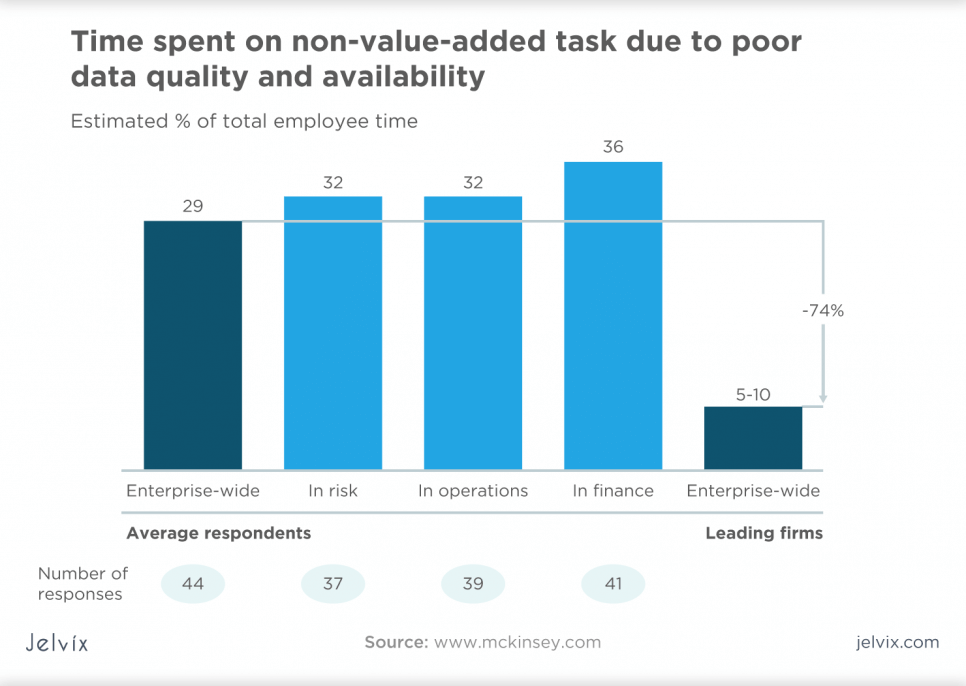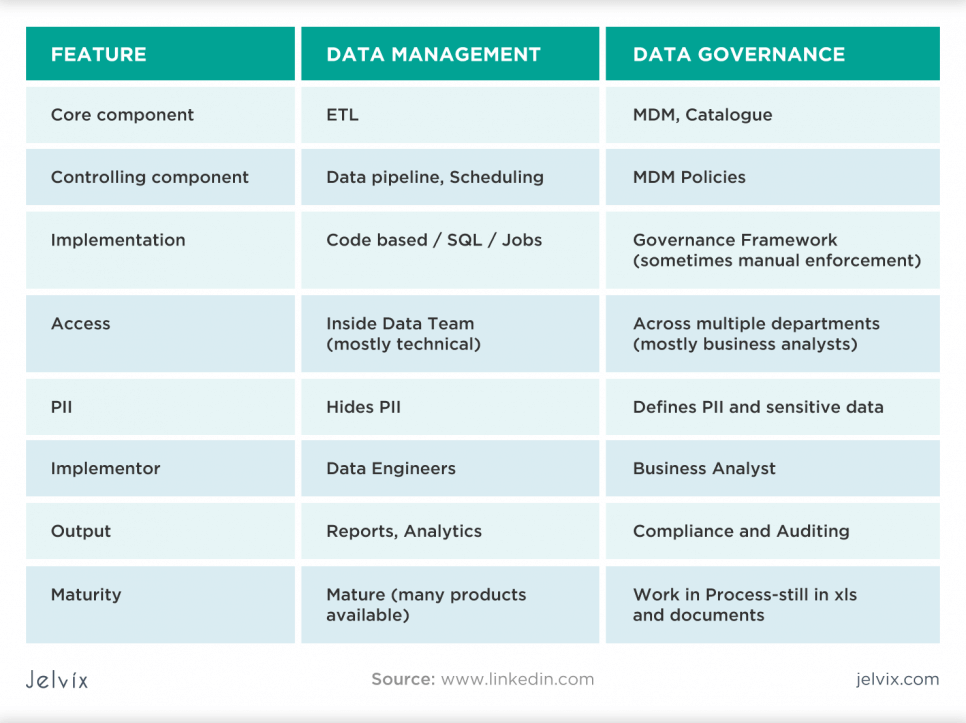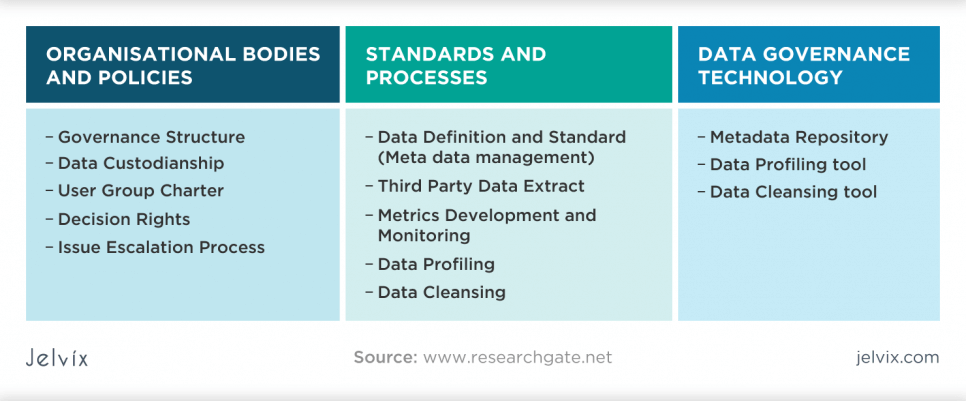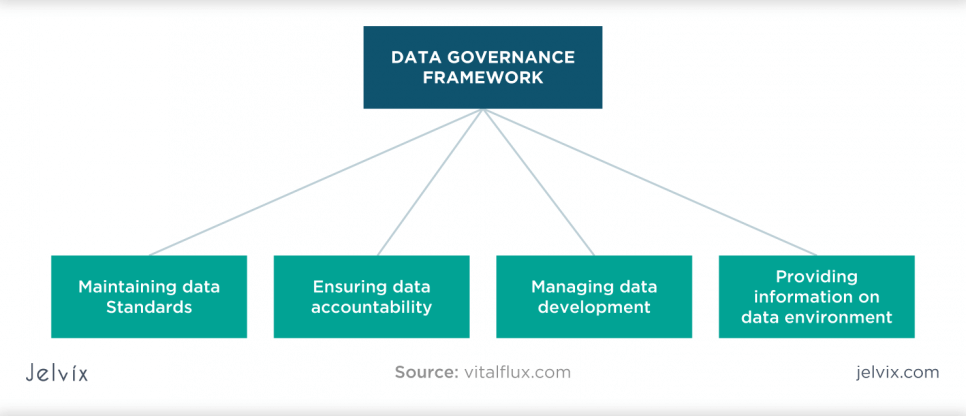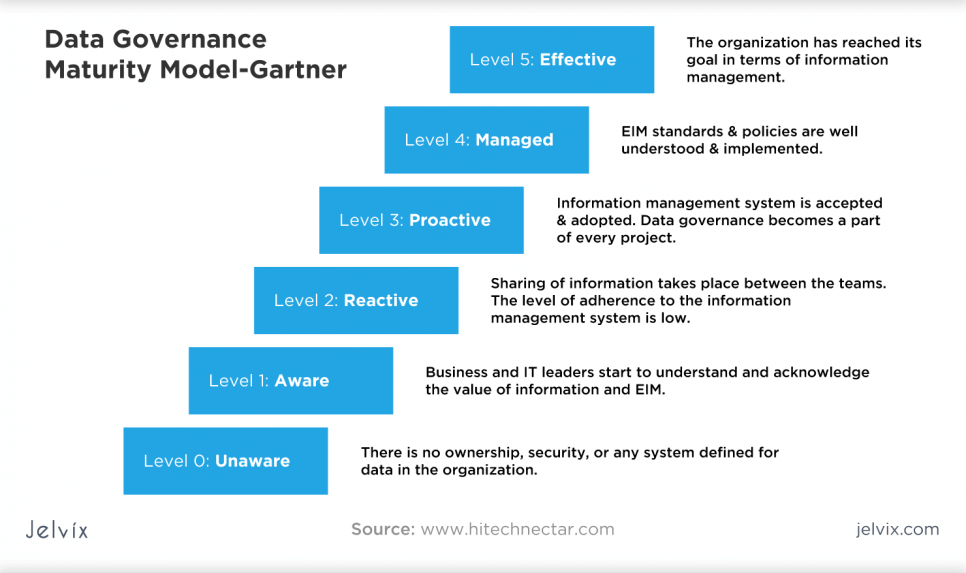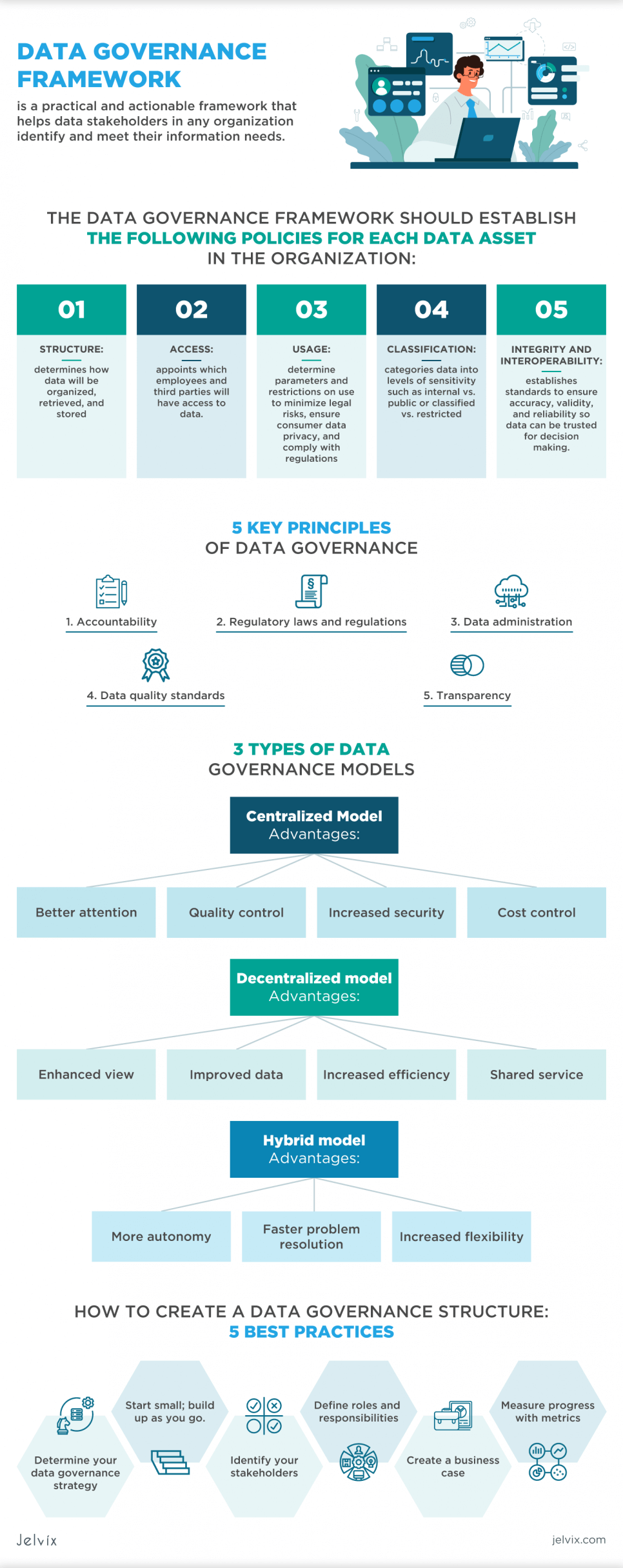Collecting, storing, and interpreting data has turned information into valuable assets that enable organizations to be more agile and competitive in a global business environment. However, you can only use these data assets for digital transformation if you can manage them effectively.
However, organizations need more than just data management; they need a management system that sets the rules for every activity. The system must break down data silos across different departments, answer questions about data ownership, and provide solutions to the growing need for big data and its various benefits.
Now is the time if you have decided to create a data governance framework. This structure should oversee data standards and delegate the necessary roles and responsibilities within your organization to the business ecosystem in which your company operates. But you need to choose the one that suits your organization and your future business goals, models, and strategies.
Let’s look at data governance, its structure, and how you can implement a data governance framework in your company.
Why is Data Governance Important?
Virtually every organization has implemented data governance framework elements to support its transformational initiatives. The data management market will be worth $136.4 billion by 2026, up from $1.81 billion in 2020.
A 2021 survey of Fortune 1000 companies shows that 48.5% of respondents use data as the basis for innovation. In addition, data-driven businesses are streamlining processes and growth plans by using structures to manage data. It is an important practice for any company looking to gain a competitive edge in today’s business environment.
Implementing a data governance framework means getting consistent, compact, and clean data. It ensures better analytics, better security and compliance, better business decisions, and better results.
The lack of a data governance structure results in managers, team leaders, or line employees being forced to make crucial decisions based on limited, outdated, or even inaccurate data. A McKinsey survey found that about 30% of all time in an organization is spent on non-value-adding tasks due to data’s poor quality and availability. Without quality governance, companies are not only missing out on data-driven opportunities; they are wasting resources.
The problem is that most management programs today are ineffective. Top management is often unaware of the potential for value creation in data governance. As a result, the program becomes a set of policies and guidelines relegated to a support function performed by the IT department and not universally applied, making data-driven initiatives equally ineffective.
In other cases, organizations are trying to use technology to solve a problem. While technology solutions such as data lakes and data management platforms can help, they are not a magic bullet.
Data Governance vs. Data Management
Although the terms “data governance” and “data management” are often used interchangeably, there is a difference.
- Data governance relates to a business’s overall enterprise data strategy, establishing appropriate use, handling, and information storage policies. Executives, stakeholders, and data trustees are answerable for creating the company data governance vision and framework.
- Data management implies the tactics used to execute the data governance strategy, ensuring data is handled per policy throughout its entire lifecycle. It also encompasses master data management, data quality and security, and database operations. Data custodians and stewards are responsible for implementing and maintaining technology and enforcing procedures and policies outlined in the data governance framework.
Both disciplines ensure that enterprise data remains a valuable business asset. It is especially important as many companies migrate their core data to the cloud, where information management and skilled data governance are critical to a successful transition.
What is a Data Governance Framework?
According to the Data Governance Institute, this is a practical and actionable framework that helps data stakeholders in any organization identify and meet their information needs. It is a specific set of principles and processes that govern how data is collected, stored, and used.
At a minimum, the data governance framework should establish the following policies for each data asset in the organization:
Structure: determines how data will be organized, retrieved, and stored;
Access: appoints who of the employees and third parties will have access to data;
Usage: determine parameters and restrictions on use to minimize legal risks, ensure consumer data privacy, and comply with regulations;
Classification: categorizes data into levels of sensitivity such as internal vs. public or classified vs. restricted;
Integrity and interoperability: establishes standards to ensure accuracy, validity, and reliability so data can be trusted for decision making.
Learn more about the main stages of product development lifecycle to build a sustainable product.
Why Do We Need a Data Governance Framework?
A data governance framework allows an organization to have complete access to data and manage it, derive value from it, minimize cost and complexity, manage risk, and ensure that the organization can meet the ever-increasing demand. It will drive business transformation at many levels within the organization:
Management: oversight of corporate data assets, their value, and their impact on changing business operations and market opportunities;
Finance: ensure consistent and accurate reporting for finance departments;
Sales and marketing: provide reliable information about customer preferences and behavior;
Procurement: strengthen cost-reduction and operational efficiency initiatives based on data and collaboration across the business ecosystem;
Manufacturing: this will be important when deploying automation;
Legal Aspects: from legal and compliance standpoints, this will be the only way to meet growing regulatory requirements
Components of a data governance framework
The data governance framework consists of the processes, policies, rules, organizational structures, and technologies implemented within the governance program. It also includes the program’s mission statement, its goals and measures of success, and decision-making responsibility and accountability for different functions that will be part of the program.
The organization’s governance structure should be documented and published so that all participants know how the program will work.
As an example, we will give the data governance framework example of the Data Governance Institute. It consists of 10 components:
5 Key Principles of Data Governance
Keep the following data governance principles in mind to ensure a successful implementation.
Accountability
Any successful data governance approach requires a high level of accountability. Data governance in an organization will be pointless, dumb, and useless if no one takes responsibility. Throughout the organization, you must implement ownership and accountability. If only one department, such as IT, takes charge, other business leaders may begin to view the company-wide problem as something that only IT needs to understand.
Tip: Create a data governance board that includes representatives from all departments, including senior executives, to ensure cross-organizational accountability. The newly formed data governance board should develop data processes and policies that will be followed throughout the organization and strictly enforced.
Regulatory laws and regulations
Every successful data governance process will need to develop and comply with uniform rules and regulations to protect data and ensure all applicable external laws process it. These standardized rules and regulations, created at the data board level and implemented by the data controller, will provide criteria for all aspects of data use.
Tip: Comply with regulations and avoid penalties by documenting the origin of data assets and access controls associated with data. Firms that underinvest in governance expose their organizations to real regulatory risk, which can be costly.
Data administration
Responsibility follows accountability for effective data governance in an organization. A dedicated data administrator is key to ensuring proper accountability for your company’s data. This person reports to the data council, enforces data rules and regulations and follows them regularly.
Tip: Optimize staff performance by providing data assets that meet the desired quality thresholds.
Data quality standards
People need to use high-quality and reliable data to make informed and productive business decisions. However, you would be surprised how few companies can fully trust their data.
Tip: Create a common set of data quality standards to improve the quality of your business data. These standards will ensure that data quality governance is assessed and documented. In addition, it helps to ensure that the entire organization knows and follows these guidelines.
Transparency
All data governance processes established in an organization should be as transparent as possible. By keeping a consistent record of all relevant data governance activities and procedures, any third-party audit to see exactly how sensitive data is handled, what you used it for, and why you used it the way you did. This openness will protect the company from a data breach and allow you to understand better how the data is being used.
Tip: Improve data security by establishing data ownership and responsibilities. In a survey conducted by McKinsey, 87% of respondents said they would not work with a company if they had concerns about its security practices, and 71% said they would stop doing business with a company if it disclosed confidential information without permission. By implementing a data governance framework, you can protect your customers’ data from potential harm.
These principles are the keystone of any effective data governance policy, allowing key personnel in the organization to assist in the implementation and regularly review compliance.
3 Types of Data Governance Models
What is a governance model? It’s a system with a basic structure that serves as the foundation and support for its many parts. A governance model represents the many feasible ways a system could work if you changed one or more elements.
There are several data governance models that you can use depending on your business needs and the types of data governance you use. We will describe three of them in more detail.
Centralized Model
In the centralized data governance model, one person is usually designated as the data manager responsible for decision-making and program management. This person is also answerable for managing the master data and distributing it to users as needed or requested.
This model is ideal for the individual business owner who manages and maintains all their data. It provides:
- Better attention: teams can focus on important tasks rather than collecting, managing, and disseminating data;
- Quality control: better business decisions can be made when data is consistent throughout the company;
- Increased security: data is easily tracked and secure, reducing the risks associated with data mishandling;
- Cost control: data centralization requires fewer resources and streamlined processes.
This model also has its disadvantages. Being a top-down approach, centralized models feed bureaucracy and often fail to meet the unique needs of each business area.
Decentralized model
A committee typically develops and manages an enterprise data governance strategy in a decentralized model. However, business functional areas create and manage their datasets and distribute information to users. The advantages of this model are:
- Enhanced view: considers all business areas and their unique challenges;
- Improved data: data is created by people who will use it for their work;
- Increased efficiency: models are easier to customize and more adaptable to changing business needs and requirements;
- Shared service: several data owners share responsibility for managing and implementing the data governance strategy.
In terms of risks, inconsistencies and duplication of key data are possible in a decentralized model, affecting consensus, reporting, and decision making.
Hybrid model
A centralized data governance framework provides the structure, technology, and best practices to follow in a hybrid model while teams work autonomously. Each business area owns its data and metadata and is free to develop standards, policies, and procedures that best suit its business needs. This federated model provides:
- More autonomy: teams manage and scale their data without impacting other groups;
- Faster problem resolution: problems are solved where and when they occur;
- Increased flexibility: teams can experiment and adjust data as the need arises.
If we talk about the shortcomings, then for such autonomy, deep knowledge in each area of business is required. And you’ll have to take steps to ensure data consistency and coordination across teams and the organization.
The maturity model
Measuring your company up against a data governance maturity model can be useful in building the roadmap and communicating the as-is and to-be part of the data governance initiative and the circumstance for deploying a data governance framework. One example of a maturity model offers Gartner, an analyst firm.
Most organizations that start creating a data governance program find themselves in the lower phases of this model.
Data management tools
Data governance is an ongoing program and not a technology solution, but some standardized management tools can help support data governance standards. They are not a required component of the platform, but support collaboration, policy development, process documentation, schedule and workflow management, data cataloging, and more. Companies can also use data quality management, metadata, and master data management tools.
The best data management tools offer IBM, Informatica, Information Builders, and data governance specialists Adaptive, ASG Technologies, Ataccama, Collibra, Erwin, Infogix, and Talend. In most cases, governance tools are a part of larger suites, including metadata management and data origin functionality.
How to Create a Data Governance Structure: 5 Best Practices
While every organization is unique, you don’t have to recreate the wheel and re-invent your structure. These data governance guidelines will help you create a roadmap.
Determine your data governance strategy
Create a data strategy by bringing together existing processes, people, and workflows. The core of a strong data governance program is getting people to take accountability. It assigns responsibilities and makes specific folks accountable for particular data domains.
Outcome: A data governance strategy helps prevent your organization from having “bad data” and poor decisions based on them.
Start small; build up as you go.
Implementing a solid data governance framework takes time. And the first thing we recommend is to find an approach that meets the needs of the business and is useful for data consumers.
Outcome: by starting with improving the quality of data in several key business processes, you will demonstrate the value of implementing corporate governance.
Identify your stakeholders
Working with relevant stakeholders to develop standards and rules for data governance is the first step toward implementing successful data governance practices.
Outcome: informing key stakeholders about the business benefits of data governance is essential to gaining support.
Define roles and responsibilities
Here are the traditional data governance roles in setting up early in the process:
- Executive sponsor: understands the concept of data management and ensures that the program has sufficient resources;
- Data governance board: guides program strategy, prioritizes projects and initiatives, and approves data definitions, policies, and standards;
- Data governance council: develops tactics and policies for using data as a business asset;
- Data owners: are responsible for the suitability or purpose of certain data areas (sometimes called a data area);
- Data stewards: ensure the quality of data elements and bring order and value to unstructured data;
- Data consumers: determines what data they require and what makes it of sufficient quality to be used.
Outcome: Assigning business outcomes and ownership levels provides fundamental support for this massive change for the organization.
Create a business case
Reaping the benefits of an enterprise-wide data management program requires dedication and investment of time and resources. It cannot be easy to convince stakeholders to take on a challenge unless you have a compelling business case.
So you can start by recognizing the core data elements and the critical business processes they support. Then, describe the costs associated with managing, integrating, and validating these elements with ongoing manual processes.
Outcome: By highlighting the potential business impact of manual process failures, you can prove the value of adopting a data governance strategy.
Measure progress with metrics
Demonstrating business value on an ongoing basis requires the development of quantitative metrics, especially concerning data quality improvement. It may include the number of quarterly data errors, resulting in revenue or cost savings. Other common data quality metrics measure datasets’ accuracy, error rate, and related attributes such as data completeness and consistency.
Outcome: The information gained from consistently tracking and collecting metrics helps maintain engagement and demonstrates the success of a data management program. Metrics display the effectiveness of processes and policies and identify areas for improvement.
Conclusion
Data governance is critical to delivering value through analytics, digitalization, and other transformational opportunities. You will succeed much faster by transforming your thinking about data governance as a foundation and policy and incorporating it strategically into your day-to-day operations.
Ready to bring industry-leading data governance to your organization? Take the next step by hiring Jelvix to develop an overall data governance strategy and framework. We use a people-centric approach and can organically launch governance based on what people are already doing.
Need a qualified team?
Boost your business capacity with the dedicated development team.



